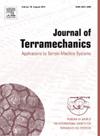Construction of a soil clod recognition bench-scale experiment for discrete element method modeling of tilling phenomena
Abstract
Rotary claws are used to break soil into small pieces and plow the soil flat. In this study, rotary claw development in tiller machines was evaluated using both equipment and the discrete element method (DEM). However, evaluation through equipment is imprecise and time consuming. Although DEM is an effective method for modeling the movement of granular materials, it requires numerous parameters to ensure accuracy, which must be determined through experimental evaluation and comparison. To resolve this concern, an image processing method was developed that leverages point cloud data obtained from a depth camera to capture changes in soil shape, distribution, and soil clod size before and after tilling. The effect of soil moisture content and claw rotation speed on soil clod formation and decomposition was evaluated. The experimental results show that the location, number, and soil clod size vary with soil moisture content and claw rotation speed. The results were compared with the DEM simulation to reconcile differences and confirm the feasibility of the proposed method. The model experiment system for soil clods and the image processing method facilitates a quantitative comparison between experimental and DEM simulated soil dispersal, which accelerates the search for DEM parameters to reproduce the tilling.

 求助内容:
求助内容: 应助结果提醒方式:
应助结果提醒方式:


